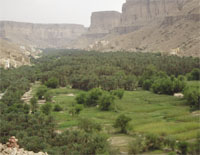
Hadramout valley: A tourism treasure trove [Archives:2007/1106/Culture]
November 26 2007
 |
As the largest valley in Yemen, Hadramout valley is a very significant and historic symbol. In his book, “Geography of the Arabian Peninsula,” famed Yemeni writer and historian Abu Mohammed Al-Hasan Al-Hamdani described the Hadramout valley as the particular characteristic of eastern Yemen. It is similar to the Moor Valley in western Yemen.
Linking the wonders of nature with the creativity of mankind, Hadramout valley is a palm oasis, as well as a source for wheat. It is also the location where the most ancient groups of humans lived on the Arabian Peninsula. It contains the city of Shibam Hadramout, which boasts the world's oldest skyscrapers. Additionally, it has the most unique architectural styles and designs existing in Yemen, and indeed on the Arabian Peninsula.
Moreover, Hadramout valley is the destination of immigrants who spread the message of Islam into Southeast Asia and North Africa. In this regard, it is the stronghold of scholars, as well as those seeking to make their fortune. For example, most of the caravans overloaded with frankincense found their way via the Hadramout valley. Thus, the area represents a treasure of Yemeni civilization.
All of the abovementioned features help make the Hadramout valley the most desired tourist destination nationwide. This is attributed to the wide spectrum contained in its tourism, traditional and modern patterns.
Cultural tourism
Cultural tourism is chief among the valley's most outstanding tourism patterns. Archeological excavations have led to the discovery of the oldest human colonies, particularly in the valleys of Du'an, Rikha and Huraidha, where the Archeological Moon Temple is located.
The valley's historic cities also have significance. Shibam Hadramout city tops those cities as it was registered on the World Heritage List as the location containing the oldest skyscrapers. Along with its sister cities of Sayoun and Tarim, it is the most important station for transporting and exporting frankincense to the outside world via Qana port.
The graves of prophets in the area offer another tourist feature to Hadramout valley. Additionally, there are many Sufi religious schools in the area, as well as other cultural centers that attract vast numbers of Arabs and Muslims. Traditional handicrafts are yet another tourist attraction to the area.
Hadrami architecture, which is that especially in the Hadramout valley and its tributaries, remains an attraction for cultural tourists from various nations worldwide.
In Hadrami architecture, which depends mainly on clay, the buildings are large and tall. With such construction being the most expensive nationwide, immigrants from the Hadramout valley readily provide their capital to prosper such architecture.
Mountain tourism
Located on a hilltop 1,000 meters above sea level, the Hadramout valley and its tributaries offer picturesque and natural views from the hills overlooking the valley. Moving from the valley to the hilltops is fundamental for mountain tourism and this area has all of the necessary features for such tourism.
Agricultural tourism
Most Hadramout valley residents mainly depend on agriculture, as they have done since the fourth millennium B.C. Wheat, dates and barley are the most important products from the area, where bees also feed on trees to produce the best varieties of honey ever tasted.
Agricultural tourism, which has begun to gain momentum all over the world, is similar to environmental tourism in terms of requirements. Tourists live in an agricultural environment, experiencing and interacting firsthand with its various components. In doing so, they learn about farmers' activities, experiences, traditions and customs prevailing in the area.
The Hadramout valley likewise is an agricultural tourism location, attracting both Arab and foreign tourists who initially come to visit the area's historic cities and view the original Hadrami architectural patterns. Such tourists also will spy Hadrami farmers wearing their distinctive cylindrical hats to cover their heads and protect them from the sun's heat.
Desert tourism
The desert of the Empty Quarter is located in northern Hadramout, comprised of both fine dunes and long rocky plains extending east to west and surrounded by sand dunes.
In the Hadramout valley, tourism is the economic sister of agriculture and it has a significant role in shaping the local economy, as the valley is one of Yemen's main tourist attractions.
——
[archive-e:1106-v:15-y:2007-d:2007-11-26-p:culture]


